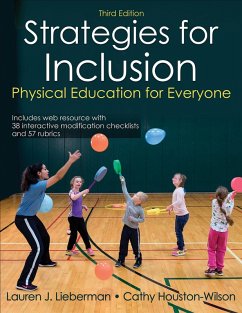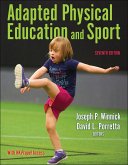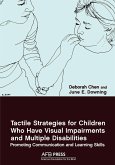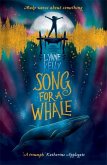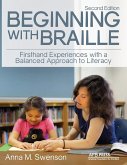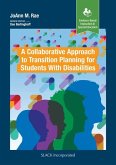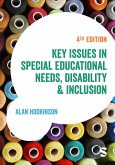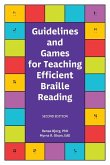- Broschiertes Buch
- Merkliste
- Auf die Merkliste
- Bewerten Bewerten
- Teilen
- Produkt teilen
- Produkterinnerung
- Produkterinnerung
Strategies for Inclusion, Third Edition, reflects the latest research and legislation and offers you the tools and strategies you need for successful inclusion. This edition includes two new chapters, additional new information, a new user-friendly web resource, and more than double the teaching units (38 units, up from 17).
Andere Kunden interessierten sich auch für
![Adapted Physical Education and Sport Adapted Physical Education and Sport]() Adapted Physical Education and Sport126,99 €
Adapted Physical Education and Sport126,99 €![Tactile Strategies for Children Who Have Visual Impairments and Multiple Disabilities Tactile Strategies for Children Who Have Visual Impairments and Multiple Disabilities]() Deborah ChenTactile Strategies for Children Who Have Visual Impairments and Multiple Disabilities52,99 €
Deborah ChenTactile Strategies for Children Who Have Visual Impairments and Multiple Disabilities52,99 €![Song for A Whale Song for A Whale]() Lynne KellySong for A Whale15,99 €
Lynne KellySong for A Whale15,99 €![Beginning with Braille Beginning with Braille]() Anna M. SwensonBeginning with Braille79,99 €
Anna M. SwensonBeginning with Braille79,99 €![A Collaborative Approach to Transition Planning for Students with Disabilities A Collaborative Approach to Transition Planning for Students with Disabilities]() JoAnn M. RaeA Collaborative Approach to Transition Planning for Students with Disabilities103,99 €
JoAnn M. RaeA Collaborative Approach to Transition Planning for Students with Disabilities103,99 €![Key Issues in Special Educational Needs, Disability and Inclusion Key Issues in Special Educational Needs, Disability and Inclusion]() Alan HodkinsonKey Issues in Special Educational Needs, Disability and Inclusion38,99 €
Alan HodkinsonKey Issues in Special Educational Needs, Disability and Inclusion38,99 €![Guidelines and Games for Teaching Efficient Braille Reading Guidelines and Games for Teaching Efficient Braille Reading]() Renae T BjorgGuidelines and Games for Teaching Efficient Braille Reading45,99 €
Renae T BjorgGuidelines and Games for Teaching Efficient Braille Reading45,99 €-
-
-
Strategies for Inclusion, Third Edition, reflects the latest research and legislation and offers you the tools and strategies you need for successful inclusion. This edition includes two new chapters, additional new information, a new user-friendly web resource, and more than double the teaching units (38 units, up from 17).
Hinweis: Dieser Artikel kann nur an eine deutsche Lieferadresse ausgeliefert werden.
Hinweis: Dieser Artikel kann nur an eine deutsche Lieferadresse ausgeliefert werden.
Produktdetails
- Produktdetails
- Verlag: Human Kinetics Publishers
- Third Edition
- Seitenzahl: 232
- Erscheinungstermin: 30. August 2017
- Englisch
- Abmessung: 279mm x 217mm x 22mm
- Gewicht: 670g
- ISBN-13: 9781492517238
- ISBN-10: 1492517232
- Artikelnr.: 48096954
- Herstellerkennzeichnung
- Libri GmbH
- Europaallee 1
- 36244 Bad Hersfeld
- gpsr@libri.de
- Verlag: Human Kinetics Publishers
- Third Edition
- Seitenzahl: 232
- Erscheinungstermin: 30. August 2017
- Englisch
- Abmessung: 279mm x 217mm x 22mm
- Gewicht: 670g
- ISBN-13: 9781492517238
- ISBN-10: 1492517232
- Artikelnr.: 48096954
- Herstellerkennzeichnung
- Libri GmbH
- Europaallee 1
- 36244 Bad Hersfeld
- gpsr@libri.de
Lauren J. Lieberman, PhD, is a distinguished service professor at the College at Brockport, State University of New York. She has taught higher education since 1995 and previously taught in the Deafblind Program at Perkins School for the Blind. She teaches undergraduate and graduate courses in adapted physical education. She is on the editorial board of the Journal of Physical Education, Recreation and Dance (JOPERD). Lieberman has written 20 books on adapted physical education and more than 118 peer-reviewed articles. She started Camp Abilities, an overnight educational sports camp for children with visual impairments. This camp is now replicated in 18 states and eight countries. Lieberman is past chair of the Adapted Physical Activity Council (APAC). She is currently on the board of the division of recreation and sport for the Association for the Education and Rehabilitation of the Blind and Visually Impaired (AER), and she serves on the board of the United States Association of Blind Athletes (USABA). She acts as a consultant for the American Printing House for the Blind and the New York Deaf-Blind Collaborative. In her leisure time, she enjoys playing Ultimate Frisbee, biking, running, kayaking, hiking, and playing the guitar. Cathy Houston-Wilson, PhD, is a professor at the College at Brockport, State University of New York. She also serves as chairperson for the department of kinesiology, sport studies, and physical education. Cathy has taught in higher education since 1993, teaching classes in adapted physical education and pedagogy. She is a frequent presenter on adapted physical education (APE) at conferences and workshops and provides in-service training on APE to school districts across New York State. Houston-Wilson has taught APE in a residential facility as well as in public schools. She is past president of the adapted physical education section of New York State AHPERD, and she is past president and a current board member of Phi Epsilon Kappa. In addition, she is actively involved in a variety of community-based activities, including Lifetime Assistance, an agency dedicated to serving individuals with developmental disabilities; SportsNet, an agency dedicated to providing sport opportunities for individuals with disabilities; Brockport Community Rowing Club, a club of which she is president and a founding member; and Camp Koinonia, a faith-based camp for families. In her leisure time, she enjoys accompanying her youngest daughter to Irish dance competitions, practicing yoga, and coaching a highly competitive girls soccer team.
Part I: Understanding Inclusion
Chapter 1: Inclusion in Physical Education
Legislative Mandates: A Historical Perspective
Placement Options in Physical Education
Roles and Responsibilities of General Physical Education Teachers
Roles and Responsibilities of Adapted Physical Education Specialists
Effectiveness of Inclusion
Summary
Chapter 2: Assessment: The Cornerstone of Effective Instruction
Features of Effective Assessment
Traditional Assessment Techniques
Authentic Assessment
Alternative Assessment
Summary
Chapter 3: The Placement Process in Physical Education
Physical Education Placement Challenges
Special Education Process
Assessing the Placement
The Lieberman/Brian Inclusion Rating Scale (LIRSPE)
Summary
Chapter 4: Individualized Education Plans
The IEP Process
The Role of Assessment in IEPs
Components of the IEP
Electronically Generated IEPs
Physical Educator's Role in the IEP Process
Incorporating Goals and Objectives Into the General Physical Education
Class
Summary
Chapter 5: Managing Student Behavior
Strategies to Avoid Behavior Problems
Understanding the Purpose of Behavior
Interventions and Strategies to Improve Behavior
Strategies to Decrease Inappropriate Behavior
Summary
Chapter 6: Universal Design for Learning
Universal Design for Learning
Universal Design in Physical Education
Differentiated Instruction
Process of Adapting Activities
Types of Adaptation
Summary
Chapter 7: Support Personnel
Peer Tutors
Paraeducators
Senior Citizens
College Students
Summary
Chapter 8: Transition Planning
Dr. Amaury Samalot-Rivera
Transition Services and the IEP
Functional Approach in Transition Planning
Transition Activities for Effective Social Inclusion
Assessment in Transition
Summary
Part II: Strategies for Inclusion
Chapter 9: Basic Skills
Balance
Body Awareness
Hula Hoops
Jump Rope
Locomotor Skills
Object Control Skills
Cooperative Games
Parachute Activities
Rhythmic Skills
Scooter Board Activities
Chapter 10: Sport Skills
Softball
Basketball
Soccer
Tennis
Badminton
Flag Football
Golf
Gymnastics
Track and Field
Volleyball
Wrestling
Chapter 11: Recreation and Leisure Skills
Backpacking and Hiking
Bowling
Fishing
Rock Climbing
Skating and In-Line Skating
Canoeing
Line Dancing
Martial Arts
Yoga
Dancing
Paddleboarding
Spikeball
Chapter 12: Health and Fitness
Aerobics
Swimming
Weight Training
Cross-Country Skiing
Fitness Activities
Appendix A: Disabilities in Kid Terms
Appendix B: Special Education Terminology
Appendix C: Brockport Aquatic Skills Checklist
Chapter 1: Inclusion in Physical Education
Legislative Mandates: A Historical Perspective
Placement Options in Physical Education
Roles and Responsibilities of General Physical Education Teachers
Roles and Responsibilities of Adapted Physical Education Specialists
Effectiveness of Inclusion
Summary
Chapter 2: Assessment: The Cornerstone of Effective Instruction
Features of Effective Assessment
Traditional Assessment Techniques
Authentic Assessment
Alternative Assessment
Summary
Chapter 3: The Placement Process in Physical Education
Physical Education Placement Challenges
Special Education Process
Assessing the Placement
The Lieberman/Brian Inclusion Rating Scale (LIRSPE)
Summary
Chapter 4: Individualized Education Plans
The IEP Process
The Role of Assessment in IEPs
Components of the IEP
Electronically Generated IEPs
Physical Educator's Role in the IEP Process
Incorporating Goals and Objectives Into the General Physical Education
Class
Summary
Chapter 5: Managing Student Behavior
Strategies to Avoid Behavior Problems
Understanding the Purpose of Behavior
Interventions and Strategies to Improve Behavior
Strategies to Decrease Inappropriate Behavior
Summary
Chapter 6: Universal Design for Learning
Universal Design for Learning
Universal Design in Physical Education
Differentiated Instruction
Process of Adapting Activities
Types of Adaptation
Summary
Chapter 7: Support Personnel
Peer Tutors
Paraeducators
Senior Citizens
College Students
Summary
Chapter 8: Transition Planning
Dr. Amaury Samalot-Rivera
Transition Services and the IEP
Functional Approach in Transition Planning
Transition Activities for Effective Social Inclusion
Assessment in Transition
Summary
Part II: Strategies for Inclusion
Chapter 9: Basic Skills
Balance
Body Awareness
Hula Hoops
Jump Rope
Locomotor Skills
Object Control Skills
Cooperative Games
Parachute Activities
Rhythmic Skills
Scooter Board Activities
Chapter 10: Sport Skills
Softball
Basketball
Soccer
Tennis
Badminton
Flag Football
Golf
Gymnastics
Track and Field
Volleyball
Wrestling
Chapter 11: Recreation and Leisure Skills
Backpacking and Hiking
Bowling
Fishing
Rock Climbing
Skating and In-Line Skating
Canoeing
Line Dancing
Martial Arts
Yoga
Dancing
Paddleboarding
Spikeball
Chapter 12: Health and Fitness
Aerobics
Swimming
Weight Training
Cross-Country Skiing
Fitness Activities
Appendix A: Disabilities in Kid Terms
Appendix B: Special Education Terminology
Appendix C: Brockport Aquatic Skills Checklist
Part I: Understanding Inclusion
Chapter 1: Inclusion in Physical Education
Legislative Mandates: A Historical Perspective
Placement Options in Physical Education
Roles and Responsibilities of General Physical Education Teachers
Roles and Responsibilities of Adapted Physical Education Specialists
Effectiveness of Inclusion
Summary
Chapter 2: Assessment: The Cornerstone of Effective Instruction
Features of Effective Assessment
Traditional Assessment Techniques
Authentic Assessment
Alternative Assessment
Summary
Chapter 3: The Placement Process in Physical Education
Physical Education Placement Challenges
Special Education Process
Assessing the Placement
The Lieberman/Brian Inclusion Rating Scale (LIRSPE)
Summary
Chapter 4: Individualized Education Plans
The IEP Process
The Role of Assessment in IEPs
Components of the IEP
Electronically Generated IEPs
Physical Educator's Role in the IEP Process
Incorporating Goals and Objectives Into the General Physical Education
Class
Summary
Chapter 5: Managing Student Behavior
Strategies to Avoid Behavior Problems
Understanding the Purpose of Behavior
Interventions and Strategies to Improve Behavior
Strategies to Decrease Inappropriate Behavior
Summary
Chapter 6: Universal Design for Learning
Universal Design for Learning
Universal Design in Physical Education
Differentiated Instruction
Process of Adapting Activities
Types of Adaptation
Summary
Chapter 7: Support Personnel
Peer Tutors
Paraeducators
Senior Citizens
College Students
Summary
Chapter 8: Transition Planning
Dr. Amaury Samalot-Rivera
Transition Services and the IEP
Functional Approach in Transition Planning
Transition Activities for Effective Social Inclusion
Assessment in Transition
Summary
Part II: Strategies for Inclusion
Chapter 9: Basic Skills
Balance
Body Awareness
Hula Hoops
Jump Rope
Locomotor Skills
Object Control Skills
Cooperative Games
Parachute Activities
Rhythmic Skills
Scooter Board Activities
Chapter 10: Sport Skills
Softball
Basketball
Soccer
Tennis
Badminton
Flag Football
Golf
Gymnastics
Track and Field
Volleyball
Wrestling
Chapter 11: Recreation and Leisure Skills
Backpacking and Hiking
Bowling
Fishing
Rock Climbing
Skating and In-Line Skating
Canoeing
Line Dancing
Martial Arts
Yoga
Dancing
Paddleboarding
Spikeball
Chapter 12: Health and Fitness
Aerobics
Swimming
Weight Training
Cross-Country Skiing
Fitness Activities
Appendix A: Disabilities in Kid Terms
Appendix B: Special Education Terminology
Appendix C: Brockport Aquatic Skills Checklist
Chapter 1: Inclusion in Physical Education
Legislative Mandates: A Historical Perspective
Placement Options in Physical Education
Roles and Responsibilities of General Physical Education Teachers
Roles and Responsibilities of Adapted Physical Education Specialists
Effectiveness of Inclusion
Summary
Chapter 2: Assessment: The Cornerstone of Effective Instruction
Features of Effective Assessment
Traditional Assessment Techniques
Authentic Assessment
Alternative Assessment
Summary
Chapter 3: The Placement Process in Physical Education
Physical Education Placement Challenges
Special Education Process
Assessing the Placement
The Lieberman/Brian Inclusion Rating Scale (LIRSPE)
Summary
Chapter 4: Individualized Education Plans
The IEP Process
The Role of Assessment in IEPs
Components of the IEP
Electronically Generated IEPs
Physical Educator's Role in the IEP Process
Incorporating Goals and Objectives Into the General Physical Education
Class
Summary
Chapter 5: Managing Student Behavior
Strategies to Avoid Behavior Problems
Understanding the Purpose of Behavior
Interventions and Strategies to Improve Behavior
Strategies to Decrease Inappropriate Behavior
Summary
Chapter 6: Universal Design for Learning
Universal Design for Learning
Universal Design in Physical Education
Differentiated Instruction
Process of Adapting Activities
Types of Adaptation
Summary
Chapter 7: Support Personnel
Peer Tutors
Paraeducators
Senior Citizens
College Students
Summary
Chapter 8: Transition Planning
Dr. Amaury Samalot-Rivera
Transition Services and the IEP
Functional Approach in Transition Planning
Transition Activities for Effective Social Inclusion
Assessment in Transition
Summary
Part II: Strategies for Inclusion
Chapter 9: Basic Skills
Balance
Body Awareness
Hula Hoops
Jump Rope
Locomotor Skills
Object Control Skills
Cooperative Games
Parachute Activities
Rhythmic Skills
Scooter Board Activities
Chapter 10: Sport Skills
Softball
Basketball
Soccer
Tennis
Badminton
Flag Football
Golf
Gymnastics
Track and Field
Volleyball
Wrestling
Chapter 11: Recreation and Leisure Skills
Backpacking and Hiking
Bowling
Fishing
Rock Climbing
Skating and In-Line Skating
Canoeing
Line Dancing
Martial Arts
Yoga
Dancing
Paddleboarding
Spikeball
Chapter 12: Health and Fitness
Aerobics
Swimming
Weight Training
Cross-Country Skiing
Fitness Activities
Appendix A: Disabilities in Kid Terms
Appendix B: Special Education Terminology
Appendix C: Brockport Aquatic Skills Checklist

